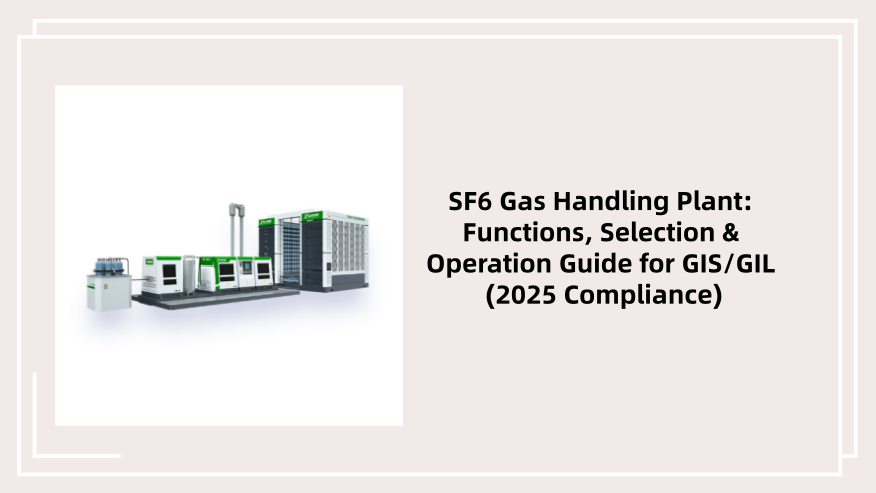In power grid operations, Gas Insulated Switchgear (GIS) and Gas Insulated Transmission Lines (GIL) depend on sulfur hexafluoride (SF6) for reliable insulation and arc quenching. However, safe, compliant SF6 management—from recovery to purification and recharging—relies entirely on a high-performance SF6 gas handling plant. With global regulations like the EU F-Gas Regulation (Regulation (EU) 2024/275) mandating 40% SF6 emission cuts by 2025, and IEC 60480 updating recovery efficiency standards, choosing and operating the right SF6 gas handling plant has become make-or-break for utilities aiming to balance reliability, safety, and sustainability. This guide breaks down core functions, selection criteria, and best practices for modern SF6 gas handling plants.
An effective SF6 gas handling plant integrates three non-negotiable modules to manage SF6 lifecycle in GIS/GIL—each aligned with latest global standards.
The recovery module is the backbone of emissions control, designed to extract SF6 during GIS/GIL maintenance or decommissioning. Modern SF6 gas handling plants meet the 2024 IEC 60480 requirement of ≥95% recovery efficiency via a two-stage process:
- Primary Recovery: High-pressure SF6 (up to 0.8 MPa, typical for 110kV GIS) is transferred to storage cylinders using a oil-free compressor (avoids oil contamination).
- Vacuum-Assisted Recovery: A rotary vane vacuum pump pulls residual SF6 to ≤5 mbar absolute pressure—critical for large GIL transmission lines (e.g., 500kV projects) where trapped gas risks emissions.
Key Compliance Note: The EU F-Gas Regulation now fines utilities €100 per kg of SF6 vented; a 95% efficient SF6 gas handling plant cuts these risks by 90% vs. older models.
Recovered SF6 often contains moisture (from GIS chamber condensation), oil (from compressors), or acidic byproducts (SO₂, HF from arcing). The purification module of an SF6 gas handling plant eliminates contaminants to meet IEC 60376 purity standards (≥99.9% SF6):
- Moisture Filters: Molecular sieves (3Å pore size) reduce moisture to ≤50 μL/L—critical for preventing insulation breakdown in 220kV+ GIS (moisture >60 μL/L increases partial discharge risk by 3x).
- Oil & Particulate Filters: 0.1 μm PTFE filters remove 99.99% of oil residues (common in older GIS) and metal particles from component wear.
- Acid Scrubbers: Calcium oxide (CaO) beds neutralize HF/SO₂, ensuring purified SF6 is safe for reuse in GIS/GIL.
Case Study: A 400kV substation in India reduced SF6 replacement costs by 35% after upgrading to an SF6 gas handling plant with advanced purification—reusing 80% of recovered gas instead of buying new.
Post-purification, the SF6 gas handling plant stores SF6 in stainless steel cylinders (DOT 3AA certified) and enables precise GIS/GIL recharging:
- Pressure Regulation: A digital pressure valve controls flow at <0.1 MPa/min to avoid turbulence (traps moisture) and overheating (chamber temp ≤40℃).
- Real-Time Monitoring: Integrated sensors (e.g., Vaisala DMT340) track SF6 moisture/pressure—alerts trigger if values exceed thresholds (prevents undercharging, which reduces GIS insulation performance).
Selecting an SF6 gas handling plant requires aligning specs with your GIS/GIL size, operational needs, and 2025 regulations. Below are the most critical factors:
Calculate capacity based on your largest GIS/GIL chamber:
- Formula: For a GIS chamber (volume = V m³), SF6 quantity = V × 6.16 kg/m³ (density at 20℃, 0.6 MPa). A 10m³ chamber needs a 50 kg/h recovery rate (10×6.16≈62 kg; 62kg ÷ 1.2h = 51.7 kg/h).
- Large Substations: Opt for ≥80 kg/h SF6 gas handling plants (e.g., for 30m³ 500kV GIS) to cut maintenance downtime (from 4h to 2h per unit).
- IEC 60480 (2024): Mandatory for recovery efficiency (≥95%) and purification (≤50 μL/L moisture).
- EU F-Gas (Regulation (EU) 2024/275): Requires CE marking and emissions tracking (plant must log SF6 usage/recovery).
- UL 1998: For North American utilities (ensures electrical safety of plant components).
Prioritize SF6 gas handling plants with:
- Touchscreen HMI: Pre-set modes for “GIS Recovery”/“GIL Recharging” (reduces operator error by 60%).
- Automatic Shutdown: Triggers for overpressure (≥1.2x max GIS pressure) or filter clogging (pressure drop >0.2 MPa).
- Data Logging: Cloud sync (e.g., AWS IoT) for regulatory reports (exports CSV/PDF of SF6 recovery volumes).
Don’t just compare upfront prices—factor in:
- Maintenance Costs: Oil-free compressors (vs. oil-lubricated) cut service costs by 40% (no oil changes).
- Energy Efficiency: IE3-rated motors reduce electricity use by 15% vs. IE2 models.
Even top-tier SF6 gas handling plants underperform without proper operation. Follow these steps to maximize efficiency and safety:
- Inspect hoses (PTFE-lined) for cracks—use a portable leak detector (e.g., Bacharach 2310) with sensitivity ≤1×10⁻⁶ mbar·L/s.
- Verify purification filters: Replace if pressure drop >0.15 MPa (check filter status via HMI).
- Label cylinders: “Purified SF6” (≤50 μL/L moisture) vs. “Contaminated SF6” (for reprocessing).
- PPE Requirements: Nitrile gloves (resist SF6), safety glasses, and oxygen monitors (≤19.5% O₂ triggers alarm) in confined spaces.
- Ventilation: For indoor use, 6 air changes per hour (use exhaust fans rated for SF6).
- No Mixing Gas: Never blend new SF6 with recovered gas unless purified to ≥99.9% (risks contamination).
As utilities pursue net-zero, SF6 gas handling plants are evolving rapidly:
- IoT-Enabled Monitoring: Siemens’ new SiGas Handling Plant uses AI to predict filter replacement (reduces unplanned downtime by 30%).
- SF6-Alternative Compatibility: ABB’s TerraPlus plant handles both SF6 and low-GWP alternatives (e.g., 3M Novec 4710)—future-proofs your investment.
- On-Site Recycling: Next-gen plants (e.g., Hitachi Energy’s SF6 Recycle System) convert contaminated SF6 to 99.99% purity on-site, eliminating transport costs.
An optimized SF6 gas handling plant isn’t just equipment—it’s a strategic asset. It cuts SF6 emissions (aligning with net-zero goals), reduces costs (35% lower new SF6 purchases via purification), and ensures GIS/GIL reliability (fewer insulation failures). For utilities upgrading in 2025, prioritize plants with 2024 IEC compliance, IoT monitoring, and low TCO—these features will define success in a regulated, sustainability-focused power industry.

Leave a Reply